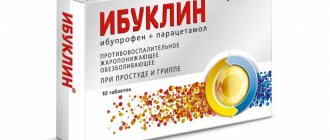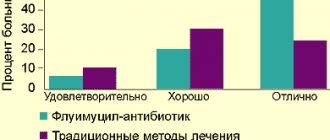Description of the medicine
ACC is available in several dosage forms:
- effervescent tablets with a dosage of 100 and 200 mg;
- effervescent tablets with an increased dosage of 600 mg (ACC Long);
- syrup with a dosage of 20 mg in 1 ml;
- powder for preparing a solution with a dosage of 100, 200 and 600 mg.
All types of the drug contain acetylcysteine as the main active ingredient.
Effervescent tablets have the shape of a flat cylinder and a score, white color and blackberry aroma. The finished medicine is colorless, transparent with a light berry aroma. Sold in cylindrical tubes of 10 or 20 pieces, which are placed in a cardboard box along with instructions.
The powder is white granules without inclusions, with a characteristic orange aroma. Sachets with powder are placed in boxes of 6 or 20 pieces, depending on the dosage of the main substance.
ACC syrup is colorless, transparent, and has a cherry aroma. Sold in 100 ml darkened glass bottles, placed in boxes, with an additional syringe or measuring cup.
ACC syrup
Release form
Syrup . Transparent, colorless, slightly viscous, with a cherry odor.
Compound
Active ingredient: acetylcysteine (20 mg/ml).
Excipients: methyl parahydroxybenzoate, sodium benzoate, disodium edetate, sodium saccharinate, sodium carmellose, sodium hydroxide, 10% aqueous solution, “Cherry” flavor, purified water.
Pharmacological group
Secretolytics and stimulants of motor function of the respiratory tract.
Action
Mucolytic agent with expectorant action. Acetylcysteine increases the volume of sputum, facilitates its discharge due to a direct effect on the rheological properties of sputum, and has an anti-inflammatory effect by suppressing the formation of free radicals and reactive oxygen-containing substances responsible for the development of inflammation in the lung tissue.
Acetylcysteine: description of the substance
Indications
Respiratory diseases and conditions accompanied by the formation of viscous and mucopurulent sputum: acute and chronic bronchitis, tracheitis, laryngotracheitis, bronchiolitis, pneumonia, lung abscess, bronchiectasis, bronchial asthma, COPD, interstitial lung diseases and atelectasis due to blockage of the bronchi by mucus plug, sinusitis (to facilitate the passage of secretions), cystic fibrosis.
Inflammation of the middle ear, acute and chronic sinusitis, rhinosinusitis.
Contraindications and restrictions
- Peptic ulcer of the stomach and duodenum in the acute phase,
- hemoptysis, pulmonary hemorrhage,
- lactation period (breastfeeding),
- children under 2 years of age,
- hypersensitivity to acetylcysteine and other components of the drug.
Carefully
- history of gastric and duodenal ulcers;
- bronchial asthma;
- liver and/or kidney failure;
- histamine intolerance (long-term use should be avoided);
- varicose veins of the esophagus;
- adrenal gland diseases;
- arterial hypertension.
Application and dosage
Orally with additional fluid intake after meals.
The syrup is taken using a measuring syringe or measuring cup contained in the package.
- Adults and children over 14 years of age: 10 ml of syrup 3 times a day;
- children from 6 to 14 years old: 5 ml of syrup 3-4 times a day;
- children from 2 to 6 years: 5 ml of syrup 2-3 times a day.
For cystic fibrosis
- Adults and children over 14 years of age: 10 ml of syrup 3 times a day;
- children from 6 to 14 years old: 5 ml of syrup 4 times a day;
- children from 2 to 6 years: 5 ml of syrup 3 times a day.
For long-term illnesses, the course of therapy is determined by the attending physician. For chronic bronchitis and cystic fibrosis, the drug should be taken for a longer period of time to achieve a preventive effect against infections.
special instructions
1 ml of syrup contains 41.02 mg of sodium, which must be taken into account when using the drug in patients on a diet with limited sodium/salt intake.
Storage
In a place protected from light, at a temperature not exceeding 30 °C. Shelf life: 3 years. Once opened, store the bottle for no more than 18 days at a temperature not exceeding 25 °C.
Production
- Sandoz d.d. (Slovenia)
- Salutas Pharma GmbH (Germany)
- Pharma Wernigerode GmbH (Germany)
Package
A bottle of 100 or 200 ml along with a dosing device in a cardboard box.
Recipe
Available without a prescription.
How does ACC work?
According to the instructions, ACC is classified as a means of thinning mucus and facilitating its removal.
Acetylcysteine can make bronchial secretions less viscous. The mucolytic effect persists even if the sputum is mixed with pus.
This substance can also increase cell protection from the effects of severe inflammation and have a detoxic effect on the body.
In people diagnosed with cystic fibrosis or chronic bronchitis, preventive treatment helps reduce the number of exacerbations and make them easier to progress.
What diseases does ACC help with?
Regardless of the form of release, ACC is used in the treatment of respiratory diseases, which are characterized by the formation of viscous secretions that are difficult to cough up.
The medication is prescribed for:
- tracheitis and laryngotracheitis;
- bronchitis (chronic, acute, obstructive);
- inflammation or abscess of the lungs;
- cystic fibrosis;
- chronic obstructive pulmonary disease;
- bronchial asthma;
- inflammation of bronchioles;
- bronchiectasis;
- sinusitis in chronic or acute form;
- otitis media.
When ACC is contraindicated, possible adverse reactions
The drug in any dosage form is not prescribed for hypersensitivity to acetylcysteine or other substances included in the composition.
The manufacturer also lists general contraindications as:
- age up to two years;
- aggravated gastric and duodenal ulcers;
- coughing up blood, bleeding from the lungs;
- state of pregnancy and breastfeeding period.
Effervescent tablets with a dosage of 100 mg are contraindicated in case of lactase deficiency, impaired absorption of substances in the intestines, or lactose intolerance.
According to the instructions, ACC 600 mg tablets and higher dosage powder are contraindicated for children under 14 years of age.
The powder is contraindicated in case of fructose intolerance, intestinal malabsorption syndrome, or sucrose deficiency.
Possible side effects of ACC have been studied in great detail. The main ones include:
- manifestations of allergies. In rare cases, itching, rashes, angioedema, increased heart rate, and a drop in blood pressure are possible. Anaphylactic shock is extremely rare;
- deterioration of the respiratory system: bronchospasms, breathing disorders;
- disruptions in the gastrointestinal tract: the appearance of heartburn, pain in the abdomen, attacks of nausea and vomiting.
Very rarely, tinnitus, headache, and fever may occur.
ACC powder
Release form
Powder for the preparation of solution for oral administration. White or yellowish in color, partially agglomerated, with an odor of orange or lemon and honey.
Compound
Active ingredient: acetylcysteine (100 or 200 mg for orange scent, 200 or 600 mg for lemon-honey scent).
Excipients:
- Lemon-honey - sucrose, ascorbic acid, sodium saccharinate, lemon flavor, honey flavor.
- Orange - sucrose, ascorbic acid, saccharin, orange flavor.
Pharmacological group
Secretolytics and stimulants of motor function of the respiratory tract.
Action
Mucolytic agent with expectorant action. Acetylcysteine increases the volume of sputum, facilitates its discharge due to a direct effect on the rheological properties of sputum, and has an anti-inflammatory effect by suppressing the formation of free radicals and reactive oxygen-containing substances responsible for the development of inflammation in the lung tissue.
Acetylcysteine: description of the substance
Indications
Respiratory diseases and conditions accompanied by the formation of viscous and mucopurulent sputum: acute and chronic bronchitis, obstructive bronchitis, tracheitis, laryngotracheitis, pneumonia, lung abscess, bronchiectasis, bronchial asthma, COPD, cystic fibrosis. Inflammation of the middle ear, acute and chronic sinusitis.
Contraindications and restrictions
- Peptic ulcer of the stomach and duodenum in the acute phase,
- hemoptysis, pulmonary hemorrhage,
- pregnancy and lactation (breastfeeding),
- children's age up to 2 years (for a dosage of 100 mg), up to 6 years (for a dosage of 200 mg), up to 14 years (for a dosage of 600 mg),
- sucrase/isomaltase deficiency, fructose intolerance, glucose-galactose deficiency,
- hypersensitivity to acetylcysteine and other components of the drug.
Carefully
- History of gastric and duodenal ulcers;
- bronchial asthma;
- obstructive bronchitis;
- liver and/or kidney failure;
- histamine intolerance (long-term use should be avoided);
- varicose veins of the esophagus;
- adrenal gland diseases;
- arterial hypertension.
Application and dosage
Inside after meals. Additional fluid intake enhances the mucolytic effect of the drug.
- Hot drink . Lemon and honey powder is dissolved in 1 glass (150-200 ml) of hot, but not boiling, water. Drink hot, but if necessary, the solution can be left for 3 hours.
- Cold drink . Orange powder is dissolved in 1 glass (150-200 ml) of water at room temperature.
Adults and teenagers over 14 years of age:
- ACC 600 mg. 1 sachet 1 time per day.
- ACC 200 mg. 1 sachet 2-3 times a day (400-600 mg per day).
- ACC 100 mg. 2 sachets 2-3 times a day (400-600 mg per day).
Children from 6 to 14 years old:
- ACC 200 mg. 1 sachet 2 times a day or 1/2 sachet 3 times a day (300-400 mg per day).
- ACC 100 mg. 1 sachet 3 times a day or 2 sachets 2 times a day (300-400 mg per day).
Children from 2 to 6 years old:
- ACC 100 mg. 1 sachet 2-3 times a day (200-300 mg per day).
- ACC 200 mg. 1/2 sachet 2-3 times a day (200-300 mg per day).
For short-term diseases, the course of treatment is 5-6 days. For long-term illnesses, the course of therapy is determined by the attending physician. For chronic bronchitis and cystic fibrosis, the drug should be taken for a longer period of time to achieve a preventive effect against infections.
For cystic fibrosis:
- Adults and children weighing ≥30 kg: if necessary, the daily dose can be increased to 800 mg per day.
- Children over 6 years: 600 mg per day.
special instructions
The drug contains sucrose, which must be taken into account when treating patients with diabetes.
When working with the drug, you must use glass containers and avoid contact with metals, rubber, oxygen, and easily oxidized substances.
Storage
In a place protected from light, at a temperature not exceeding 25 °C. Shelf life - 3 years (lemon-honey), 4 years (orange).
Production
- Sandoz d.d. (Slovenia)
- Salutas Pharma GmbH (Germany)
- Lindopharm GmbH (Germany)
Package
Powder 3 g in a bag of three-layer material, 6, 10, 20 or 50 bags in a cardboard box.
Recipe
Available without a prescription.
How to take ACC
The dosage regimen and dosage of the drug depend on the patient’s age. ACC is taken orally and always after meals.
Syrup:
- adults and adolescents over 14 years of age - 10 ml twice or thrice a day;
- children 6-14 years old - 5 ml 3-4 times or 10 ml twice a day;
- children 2-6 years old - 5 ml twice or thrice a day.
ACC 100 mg (one tablet or one sachet):
- adults and adolescents over 14 years of age – 2 tablets/2 sachets twice or thrice a day;
- children 6-14 years old – 1 tablet/1 sachet three times a day or 2 tablets/2 sachets twice a day;
- children 2-6 years old - 1 tablet/1 sachet twice or thrice a day.
ACC Long adults and adolescents from 14 years of age take one effervescent tablet once a day.
Patients with cystic fibrosis are allowed to increase the dose of acetylcysteine to 800 mg per day.
Effervescent tablets must be dissolved in 200 ml of water; the solution should be drunk immediately after preparation. The powder is dissolved in non-hot tea, water or juice.
During therapy, it is advisable to drink more fluid to better thin the mucus.
The duration of treatment for coughing against the background of ARVI is no more than a week.
Chronic bronchitis and cystic fibrosis are indications for longer courses.
Buy ACC 100 powder for preparing a solution for oral administration Orange for children 3g No. 20 in pharmacies
ACC Buy ACC in pharmacies DOSAGE FORMS granules for the preparation of solution for oral administration orange 100 mg
MANUFACTURERS Salutas Pharma GmbH (Germany)
GROUP Mucolytic agents
COMPOSITION The active substance is acetylcysteine.
INTERNATIONAL NON-PROPENTED NAME Acetylcysteine
SYNONYMS Acetylcysteine, Acetylcysteine Sediko effervescent instant, Acetylcysteine Stada International, Acetylcysteine-Hemofarm, ACC 100, ACC 200, ACC injection, ACC Long, Vicks Active ExpectoMed, Muco Sanigen, Mukobene, Mukonex, Tussicom, Fluimucil
PHARMACOLOGICAL ACTION Mucolytic agent. Pharmacodynamics. The presence of sulfhydryl groups in the structure of acetylcysteine promotes the rupture of disulfide bonds of acidic mucopolysaccharides of sputum, which leads to a decrease in the viscosity of mucus. The drug remains active in the presence of purulent sputum. With the prophylactic use of acetylcysteine, there is a decrease in the frequency and severity of exacerbations in patients with chronic bronchitis and cystic fibrosis.
INDICATIONS FOR USE Diseases of the respiratory system, accompanied by the formation of viscous, difficult to separate sputum: acute and chronic bronchitis, obstructive bronchitis, laryngotracheitis, pneumonia, bronchiectasis, bronchial asthma, bronchiolitis, cystic fibrosis. Acute and chronic sinusitis, inflammation of the middle ear (otitis media).
CONTRAINDICATIONS Hypersensitivity to acetylcysteine or other components of the drug, pregnancy, breastfeeding, children under 2 years of age.
SIDE EFFECTS In rare cases, headaches, inflammation of the oral mucosa (stomatitis) and tinnitus are observed. Extremely rare - diarrhea, vomiting, heartburn and nausea, drop in blood pressure, increase in heart rate (tachycardia). In isolated cases, allergic reactions such as bronchospasm (mainly in patients with bronchial hyperreactivity), skin rash, itching and urticaria are observed. In addition, there are isolated reports of bleeding due to hypersensitivity reactions. If side effects develop, you should stop taking the drug and consult a doctor.
INTERACTION With the simultaneous use of acetylcysteine and antitussives, mucus stagnation may occur due to suppression of the cough reflex. Therefore, such combinations should be selected with caution. The simultaneous use of acetylcysteine and nitroglycerin can lead to an increase in the vasodilatory effect of the latter. Pharmaceutically incompatible with antibiotics (penicillins, cephalosporins, erythromycin, tetracycline and amphotericin B) and proteolytic enzymes. Upon contact with metals and rubber, sulfides with a characteristic odor are formed. Reduces the absorption of penicillins, cephalosporins, tetracycline (they should be taken no earlier than 2 hours after ingestion of acetylcysteine).
METHOD OF APPLICATION AND DOSAGE In the absence of other prescriptions, it is recommended to adhere to the following dosages: Mucolytic therapy. Adults and adolescents over 14 years of age are recommended to take 1 sachet 2 - 3 times a day (400 - 600 mg per day). Children aged 6 to 14 years are recommended to take ACC® 200 mg 3 times a day, 1 sachet or 2 times a day, 1 sachet (300 - 400 mg per day). Children aged 2 to 5 years are recommended to take 2-3 times a day, 1/2 sachet (200-300 mg per day). Cystic fibrosis. Children over 6 years of age are recommended to take 1 sachet (600 mg per day) 3 times a day. Children aged 2 to 5 years are recommended to take 1/2 sachet (400 mg per day) 4 times a day. For patients with cystic fibrosis and a body weight of more than 30 kg, if necessary, the dose can be increased to 800 mg of acetylcysteine per day. The granules should be dissolved in water, juice or iced tea and taken after meals.
OVERDOSE In case of erroneous or intentional overdose, phenomena such as diarrhea, vomiting, stomach pain, heartburn and nausea are observed. To date, no severe or life-threatening side effects have been observed.
SPECIAL INSTRUCTIONS With caution - peptic ulcer of the stomach and duodenum in the acute stage; hemoptysis, pulmonary hemorrhage, esophageal varices, bronchial asthma, adrenal diseases, liver and/or kidney failure. Pregnancy and breastfeeding For safety reasons, due to insufficient data, the use of the drug during pregnancy and breastfeeding is only possible if the expected benefit to the mother outweighs the potential risk to the fetus or infant. For patients with bronchial asthma and obstructive bronchitis, acetylcysteine should be prescribed with caution under systematic monitoring of bronchial patency. When treating patients with diabetes, it is necessary to take into account that the drug contains sucrose. When working with the drug, you must use glass containers and avoid contact with metals, rubber, oxygen, and easily oxidized substances.
STORAGE CONDITIONS Store in a dry place, protected from light, at a temperature not exceeding 25 C.






